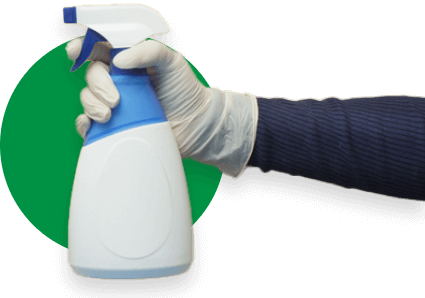Warehouse disinfection eliminates harmful bacteria and viruses from industrial workspaces using EPA-registered chemicals. Professional warehouse disinfection prevents 95 million annual workdays lost to slip-and-fall accidents. Systematic warehouse disinfection protocols support waste management, inventory protection, workplace safety, and employee health.
Steps for Warehouse Disinfection
Warehouse disinfection follows systematic procedures ensuring comprehensive facility sanitization. Professional disinfecting services implement these protocols, maintaining safe industrial environments.
- Complete prep work, organizing checklists, goals, supplies, and team assignments.
- Perform preliminary cleaning, eliminating obvious surface debris from equipment and high-touch areas.
- Clean high areas, including ceilings, walls, and light fixtures, preventing dust accumulation.
- Sanitize and disinfect all floors using appropriate cleaners with proper techniques.
- Review completed checklists, ensuring thorough coverage without missed areas or safety gaps.
Variation by Warehouse Type
Warehouse disinfection protocols adapt to specific operational requirements and contamination risks:
- Distribution Warehouses: Focus on loading docks, package handling areas, and high-traffic zones with daily disinfection of touchpoints and weekly deep cleaning cycles.
- Cold Storage Facilities: Address moisture control, condensation management, and temperature-appropriate disinfectants, preventing mold growth in refrigerated environments.
- Manufacturing Warehouses: Emphasize machinery cleaning, production area disinfection, and contamination prevention protocols protecting both products and workers from cross-contamination.
- E-Commerce Fulfillment Centers: Prioritize packing stations, conveyor systems, and employee break areas with multiple daily disinfection cycles supporting 24/7 operations.
Why Warehouse Disinfection Matters
Warehouse disinfection directly impacts productivity and worker safety. Slip-and-fall accidents cause 95 million lost workdays annually. These preventable incidents significantly affect operational efficiency. Proper warehouse disinfection maintains clean floors, reducing accident risks.
Professional warehouse disinfection supports multiple critical functions. Waste management prevents bacterial accumulation. Inventory management protects stored products from contamination. Safety protocols reduce workplace injuries. Understanding industrial disinfecting services clarifies comprehensive protection requirements.
Workplace hygiene through warehouse disinfection keeps employees healthy and productive. Consistent sanitization prevents illness transmission between workers. This reduces absenteeism while maintaining operational capacity during peak periods.
Warehouse Disinfection Impact on Operations
Professional warehouse disinfection delivers measurable operational improvements:
| Metric | Without Regular Disinfection | With Professional Disinfection |
| Workplace accidents | 95M workdays lost annually | Significantly reduced incidents |
| Employee illness rates | Higher absenteeism | Reduced sick days |
| Inventory contamination | Product damage risk | Protected stored goods |
| Operational efficiency | Disrupted by accidents | Maintained productivity |
| Regulatory compliance | Potential violations | Safety standards met |
This data demonstrates why warehouse disinfection represents essential operational infrastructure rather than an optional maintenance expense.
Daily Warehouse Disinfection Checklist
Daily warehouse disinfection prevents bacterial and viral accumulation. Failing these protocols results in avoidable illness and injury.
Essential daily warehouse disinfection tasks include:
- High-Touch Surfaces: Clean and sanitize door handles, light switches, shelves, and control panels contacted by multiple workers throughout shifts.
- Equipment Sanitization: Disinfect pallets, trolleys, trolley handles, grab bars, and keys, preventing pathogen transmission through shared tools.
- Countertop Disinfection: Wipe all work surfaces, packing stations, and administrative areas with EPA-registered disinfectants, allowing proper contact times.
- Floor Maintenance: Sweep or vacuum, removing debris, then mop using appropriate warehouse floor cleaners, preventing slip hazards.
- Waste Management: Empty all receptacles and sanitize containers daily, preventing bacterial growth and unpleasant odors from accumulated garbage.
- Restroom Protocols: Clean toilets, urinals, sinks, and countertops with disinfectants, and refill soap, tissues, and toilet paper supplies.
These daily warehouse disinfection tasks maintain baseline cleanliness, preventing contamination accumulation requiring extensive remediation. Comprehensive warehouse cleaning practices provide additional operational guidance.
Weekly Warehouse Disinfection Requirements
Weekly warehouse disinfection addresses areas requiring less frequent but thorough attention. These protocols complement daily maintenance.
Weekly warehouse disinfection priorities include:
- Equipment Maintenance: Inspect and clean machinery, forklifts, and automated systems, ensuring proper function while preventing contamination buildup affecting performance.
- Window and Curtain Cleaning: Disinfect windows, curtains, and skylights, maximizing natural light while preventing dust accumulation on glass surfaces.
- High Surface Dusting: Address ceilings, door frames, light fixtures, wall partitions, and high shelves where dust accumulates beyond daily cleaning reach.
- Organizational Maintenance: Reorganize pallets and shelves as needed, maintaining accessibility while identifying contamination or damage requiring attention.
- Glass Fixture Polishing: Clean windows, doors, glass walls, and partitions, maintaining visibility and professional appearance throughout the facility.
- Supply Restocking: Check and replenish cleaning supplies, safety equipment, and sanitization products, ensuring continuous protocol compliance.
Weekly warehouse disinfection prevents long-term contamination buildup while maintaining facility aesthetics and operational efficiency.
Monthly Warehouse Disinfection Deep Cleaning
Monthly warehouse disinfection focuses on comprehensive deep cleaning, preventing hazardous conditions. These intensive protocols address areas that daily and weekly cleaning cannot reach.
Critical monthly warehouse disinfection includes:
- Wall Deep Cleaning: Scrub walls thoroughly, removing accumulated dirt, dust, and potential mold growth from vertical surfaces often neglected in routine cleaning.
- Pathway Sanitization: Clean walkways and pathways of dirt, dust, snow, ice, and hazardous materials, preventing slip-and-fall accidents during all weather conditions.
- Mold and Mildew Inspection: Examine drains, sinks, corners, and moisture-prone areas for contamination signs requiring immediate remediation before widespread growth.
- Floor Deep Cleaning: Use industrial-strength floor cleaners, steam clean hard surfaces, and shampoo carpets, eliminating embedded contaminants that routine mopping cannot remove.
- Pest Management: Inspect for mice, rats, insects, and other pests requiring professional extermination, preventing inventory contamination and health code violations.
- Upholstery Maintenance: Change or deep clean upholstery covers in break rooms and office areas, eliminating absorbed odors and embedded pathogens.
- Exterior Cleaning: Power wash warehouse exterior, loading docks, steps, and entry areas, maintaining a professional appearance while preventing outdoor contamination transfer.
Understanding when to deep-clean warehouses optimizes scheduling for minimal operational disruption.
Prep Work for Effective Warehouse Disinfection
Thorough preparation accelerates warehouse disinfection while ensuring comprehensive coverage. An organization prevents overlooked areas and wasted time.
Essential prep work includes:
- Checklist Organization: Prepare daily, weekly, and monthly checklists with clear task assignments, preventing confusion during execution.
- Goal Clarification: Define specific objectives for each cleaning session, ensuring team members understand priorities and expected completion standards.
- Supply Verification: Stock all cleaning supplies, disinfectants, equipment, and safety gear before starting, preventing mid-task delays from missing materials.
- Team Coordination: Brief all cleaning staff on assignments, protocols, reporting procedures, and emergency contacts, ensuring smooth operations.
- Schedule Communication: Coordinate with warehouse operations, preventing conflicts between cleaning activities and business operations requiring space access.
Proper prep work transforms warehouse disinfection from reactive scrambling to systematic execution, delivering consistent results.
Preliminary Warehouse Disinfection Cleaning
Preliminary cleaning removes obvious surface debris before intensive disinfection. This crucial step prevents organic matter from shielding pathogens.
Preliminary warehouse disinfection focuses on:
- Surface Debris Removal: Sweep, wipe, and vacuum visible dirt, dust, and contaminants from all surfaces, preparing them for disinfectant application.
- High-Touch Area Attention: Clean doorknobs, handrails, equipment controls, and frequently-contacted surfaces that appear dirty, requiring immediate sanitization.
- Equipment Preliminary Cleaning: Remove dust, dirt, and debris from machinery, forklifts, conveyors, and tools before applying disinfectants.
- Trash Collection: Remove accumulated garbage, packaging materials, and waste, preventing bacterial growth and unpleasant odors during intensive cleaning.
Preliminary warehouse disinfection establishes a foundation for effective pathogen elimination during subsequent disinfection phases.
High Area Warehouse Disinfection
Neglecting high areas during warehouse disinfection creates contamination reservoirs. Dust, dirt, debris, and mold accumulate in ceiling spaces.
High area warehouse disinfection requires:
- Ceiling Cleaning: Use telescoping equipment or lifts to reach ceiling surfaces, beams, and structural elements that accumulate dust and potential mold.
- Light Fixture Sanitization: Clean light fixtures, bulbs, and covers, improving illumination while preventing dust circulation through facility air systems.
- High Wall Treatment: Address wall surfaces above normal reach where dust settles, creating visible contamination and potential air quality issues.
- Ventilation System Attention: Clean HVAC vents, ducts, and air handling equipment, preventing pathogen circulation through facility ventilation systems.
Professional equipment and proper safety protocols enable effective high-area warehouse disinfection without worker injury risk.
Floor Sanitization and Disinfection Protocols
Floor warehouse disinfection prevents the majority of slip-and-fall accidents. Floors require daily, weekly, and monthly attention using appropriate methods.
Comprehensive floor warehouse disinfection includes:
- Daily Floor Maintenance: Sweep or vacuum to remove debris, then mop with EPA-registered floor disinfectants, maintaining a wet contact time for pathogen elimination.
- Weekly Floor Treatment: Apply floor polish, address high-traffic wear patterns, and deep clean specific problem areas receiving concentrated traffic.
- Monthly Floor Deep Cleaning: Steam clean hard surfaces, shampoo carpets, and strip/reapply floor finishes, restoring surfaces to optimal condition.
- Restroom Floor Protocols: Clean bathroom floors with germicidal solutions multiple times daily, addressing moisture and high contamination risk.
Proper floor warehouse disinfection techniques prevent accidents while maintaining professional facility appearance. Industrial floor cleaning methods provide specialized technique guidance.

Checklist Review and Quality Assurance
Final warehouse disinfection review ensures comprehensive coverage. Double-checking prevents overlooked areas requiring attention.
Checklist review process includes:
- Systematic Verification: Walk through the facility, comparing completed tasks against checklist items, confirming that everything received proper attention.
- Problem Area Identification: Note any areas requiring additional attention, special treatment, or maintenance beyond routine cleaning protocols.
- Supply Assessment: Verify adequate cleaning supply inventory for next session, identifying items needing reordering to prevent future shortages.
- Documentation Completion: Record all completed tasks, issues discovered, and recommendations for future sessions, maintaining continuity between cleaning teams.
A thorough checklist review transforms warehouse disinfection from task completion to quality assurance, ensuring consistent facility standards.
Common Warehouse Disinfection Challenges
Warehouse disinfection presents unique obstacles requiring strategic solutions. Understanding challenges enables proactive planning.
Typical warehouse disinfection challenges include:
- Facility Size Management: Warehouses exceeding 20,000 square feet, jam-packed with equipment, require extensive time and systematic approaches to prevent overlooked areas.
- Operational Disruption Prevention: Balancing cleaning schedules with business operations demands clear communication and flexible protocols accommodating both requirements.
- Equipment Maintenance Coordination: Inadequate equipment care allows dirt and debris accumulation, requiring extensive remediation during professional warehouse disinfection.
- Hard-to-Reach Areas: High ceilings, tight spaces between storage racks, and equipment-blocked areas demand specialized tools and safety equipment.
Professional warehouse disinfection services navigate these challenges through experience, proper equipment, and systematic protocols. Learning warehouse cleaning best practices improves operational efficiency.
Warehouse Disinfection Best Practices
Following proven warehouse disinfection strategies maximizes effectiveness while minimizing time investment.
Essential warehouse disinfection best practices include:
- Maintain Detailed Plans: Organize checklists, strategies, and supply inventories before starting, preventing improvisation and overlooked areas during execution.
- Create Realistic Schedules: Develop timetables accounting for actual task duration and operational constraints, ensuring completion without rushing, compromising quality.
- Prevent Garbage Accumulation: Empty waste receptacles at a minimum daily frequency to prevent bacterial growth, unpleasant odors, and pest attraction in the facility.
- Protect Inventory Cleanliness: Regularly inspect and clean stored products, preventing dust accumulation and contamination, protecting business assets.
- Coordinate Operations: Communicate cleaning schedules with warehouse management, preventing conflicts between sanitation activities and business operations.
These warehouse disinfection best practices transform cleaning from a burden to a systematic process delivering consistent results.
Why Outsource Professional Warehouse Disinfection
Professional warehouse disinfection services provide specialized expertise beyond in-house capabilities. Qualified teams deliver superior results.
Benefits of professional warehouse disinfection include:
- Specialized Equipment Access: Professional services use industrial-strength vacuums, steam cleaners, power washers, and safety equipment, surpassing typical facility inventories.
- Regulatory Compliance Knowledge: Trained teams understand OSHA requirements, EPA regulations, and industry standards, ensuring compliant warehouse disinfection protocols.
- Efficiency Through Experience: Professional crews complete tasks faster using proven techniques and systematic approaches developed through extensive warehouse experience.
- Reduced Liability: Outsourced services assume responsibility for cleaning injuries, accidents, and insurance requirements, removing facility burden.
- Consistent Quality Standards: Regular professional service maintains facility appearance and safety through documented protocols and quality assurance procedures.
Understanding industrial warehouse cleaning service requirements helps evaluate professional providers effectively.
Get Professional Warehouse Disinfection Services from Dallas Janitorial Services
Warehouse disinfection protects employee health while maintaining operational efficiency and regulatory compliance. Professional protocols prevent the 95 million workdays lost annually to preventable workplace accidents. Dallas Janitorial Services brings decades of industrial facility expertise to Dallas-Fort Worth warehouse operations. Contact us today for a customized warehouse disinfection assessment and service planning.
Frequently Asked Questions About Warehouse Disinfection
How often should warehouse disinfection occur?
Warehouse disinfection frequency depends on specific operations. Most facilities require daily cleaning with weekly intensive protocols and monthly deep cleaning. High-traffic warehouses may need multiple daily warehouse disinfection cycles.
Why do warehouses need regular disinfection?
Warehouse disinfection maintains clean, organized spaces, saving time, eliminating waste, keeping workers safe from illness and injury, and efficiently managing inventory, preventing contamination and product damage.
How do you clean warehouse floors properly?
Warehouse floors require industrial-strength vacuums with powerful suction, removing dirt, debris, and dust. Mopping with EPA-registered disinfectants follows debris removal. Monthly deep cleaning addresses embedded contamination.
What’s the difference between sanitizing and disinfecting warehouses?
Sanitizing eliminates bacteria on warehouse surfaces but doesn’t eliminate viruses. Warehouse disinfection kills both bacteria and viruses using EPA-registered chemicals. Both terms are often used interchangeably.
Why does warehouse disinfection improve business productivity?
Warehouse disinfection improves productivity through waste management, inventory protection, safety enhancement, and workplace hygiene. Proper disinfection reduces accidents and illnesses, maintaining operational capacity.
What are common warehouse disinfection challenges?
Common warehouse disinfection challenges include managing large spaces exceeding 20,000 square feet, coordinating with ongoing operations, addressing inadequate equipment maintenance, and accessing hard-to-reach areas safely.







